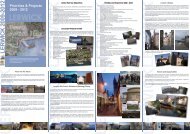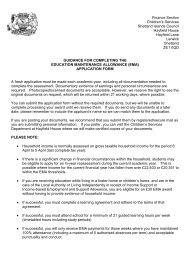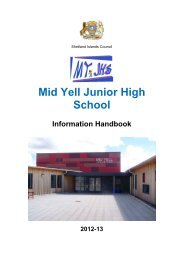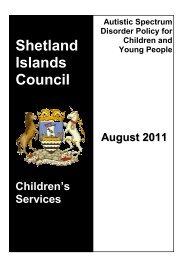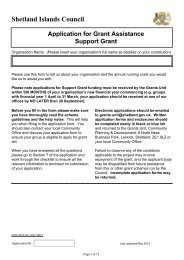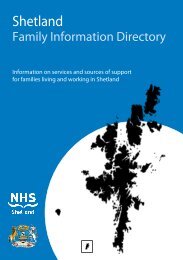Shetland Local Landscape Designation Review: Final Report
Shetland Local Landscape Designation Review: Final Report
Shetland Local Landscape Designation Review: Final Report
You also want an ePaper? Increase the reach of your titles
YUMPU automatically turns print PDFs into web optimized ePapers that Google loves.
Candidate <strong>Local</strong> <strong>Landscape</strong> Area 8: Scat Ness and Sumburgh Head<br />
Location and boundaries:<br />
These two headlands form the rocky southern tip of Mainland <strong>Shetland</strong>. The northern boundary<br />
of this area follows the A970 as it skirts the airport and separates the promontories from the<br />
developed area around the airfield.<br />
Key characteristics:<br />
<br />
<br />
<br />
<br />
Dramatic headlands jutting into the open sea<br />
Rich historical background represented by world-class archaeological sites<br />
The distinctive approach to Sumburgh Airport across the headland<br />
An accessible area for viewing scenery, history and wildlife<br />
<strong>Designation</strong> statement:<br />
Scat Ness is the lower lying headland, occupied in the north by the village of Scatness, which<br />
illustrates a traditional pattern of tofts, although overlaid with more recent development. South<br />
of the settlement, the headland becomes more open, breaking up into a series of rocky spits and<br />
geos. Its southern extremity, the Ness of Burgi, is accessible by a narrow rocky path with the<br />
sea on either side, and only a metal chain for protection. Once past this narrow exposed neck,<br />
the headland broadens out, and is topped by a well preserved Iron Age blockhouse. Low cliffs<br />
fall sharply to jagged skerries and clear shallow seas on all sides. The smaller islands around Scat<br />
Ness, including Lady’s Holm, Little Holm and Horse Island, form part of the setting of these<br />
headlands. The two headlands are linked by a long beach of grey-white sand.<br />
Sumburgh Head is much more upstanding. Although low and relatively gentle on its western<br />
side, it rises to over 100m at Compass Head, with steep cliffs on its eastern face. It narrows<br />
southward in an arrowhead shape to an angular headland, with rocky slopes tilting sharply into<br />
the sea, and surrounded by knife-edged offshore rocks. The lighthouse on the headland is a<br />
landmark, and along with several aerials and masts, is visible from aeroplanes approaching<br />
Sumburgh Airport. The angled descent onto the runway is a distinctive feature of arrival into<br />
<strong>Shetland</strong> for many visitors. This area is also very accessible: a public road links the lighthouse<br />
with viewpoints and car parks, and the headland is a popular bird reserve. The multi-layered<br />
archaeological site of Jarlshof is located on Sumburgh Head.<br />
Development guidelines:<br />
<br />
<br />
<br />
Seek to resist the further proliferation of communications equipment on Sumburgh Head,<br />
which may give rise to visual clutter<br />
Seek to retain the pattern of tofts in Scatness. Development within the settlement should<br />
be sympathetically sited and designed. The open, undeveloped nature of the southern part<br />
of Scat Ness should be maintained<br />
In planning for access, the distinction between the more accessible Sumburgh Head and the<br />
less accessible Ness of Burgi should be retained to preserve their individual characters<br />
<strong>Shetland</strong> Islands <strong>Local</strong> <strong>Landscape</strong> <strong>Designation</strong> <strong>Review</strong><br />
Land Use Consultants<br />
<strong>Final</strong> <strong>Report</strong> 68 October 2011



